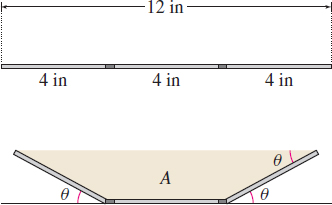EXAMPLE 5Constructing a Rain Gutter
A rain gutter is to be constructed using a piece of aluminum 12 in wide. After marking a length of 4in. from each edge, the piece of aluminum is bent up at an angle θ, as illustrated in Figure 19. The area A of a cross section of the opening, expressed as a function of θ, is A(θ)=16 sin θ(cosθ+1)0≤θ≤π2
Find the angle θ that maximizes the area A. (This bend will allow the most water to flow through the gutter.)
Solution The function A=A(θ) is continuous on the closed interval [0,π2]. To find the angle θ that maximizes A, we follow the three-step procedure.
Step 1 We locate all critical numbers in the open interval (0,π2). A′(θ)=16sinθ(−sinθ)+16cosθ(cosθ+1)Product Rule=16[−sin2θ+cos2θ+cosθ]=16[(cos2θ−1)+cos2θ+cosθ]−sin2θ=cos2θ−1=16[2cos2θ+cosθ−1]=16(2cosθ−1)(cosθ+1)
The critical numbers satisfy the equation A′(θ)=0,0<θ<π2. 16(2cosθ−1)(cosθ+1)=02cosθ−1=0 or cosθ+1=0cosθ=12 cosθ=−1θ=π3or5π3 θ=π
Of these solutions, only π3 is in the interval (0,π2). So, π3 is the only critical number.
271
Step 2 We evaluate A at the critical number π3 and at the endpoints 0 and π2.
| θ | 16sinθ(cosθ+1) | A(θ) | |
|---|---|---|---|
| 0 | 16sin0(cos0+1)=0 | 0 | |
| π3 | 16sinπ3(cosπ3+1)=16(√32)(12+1)=16(3√34)=12√3 | ≈20.8 | ⟵ absolute maximum value |
| π2 | 16sinπ2(cosπ2+1)=16(1)(0+1)=16 | 16 |
Step 3 If the aluminum is bent at an angle of π3, the area of the opening is maximum. The maximum area is about 20.8in2.
